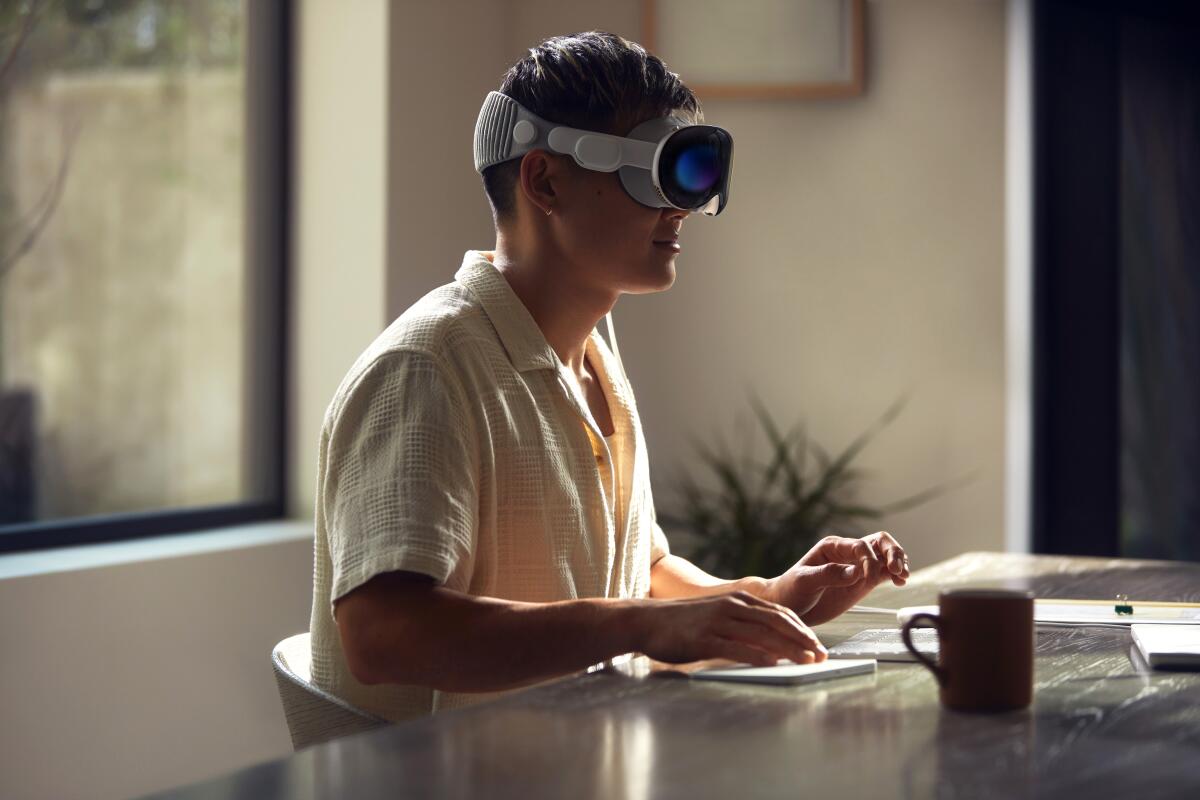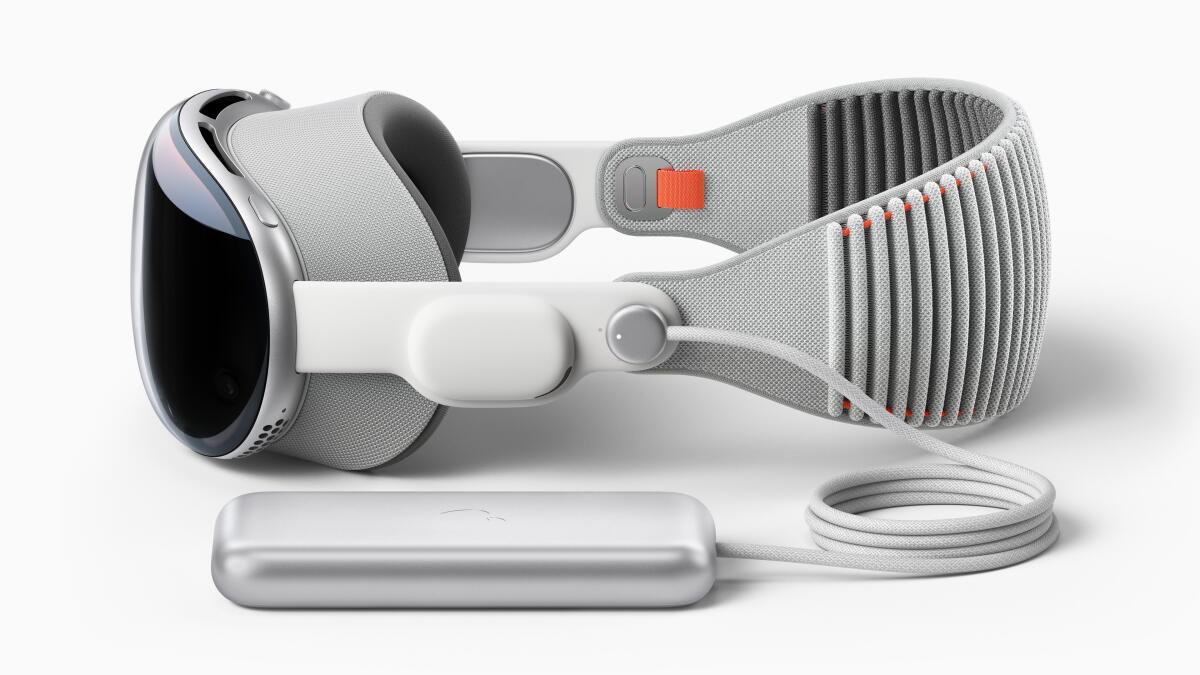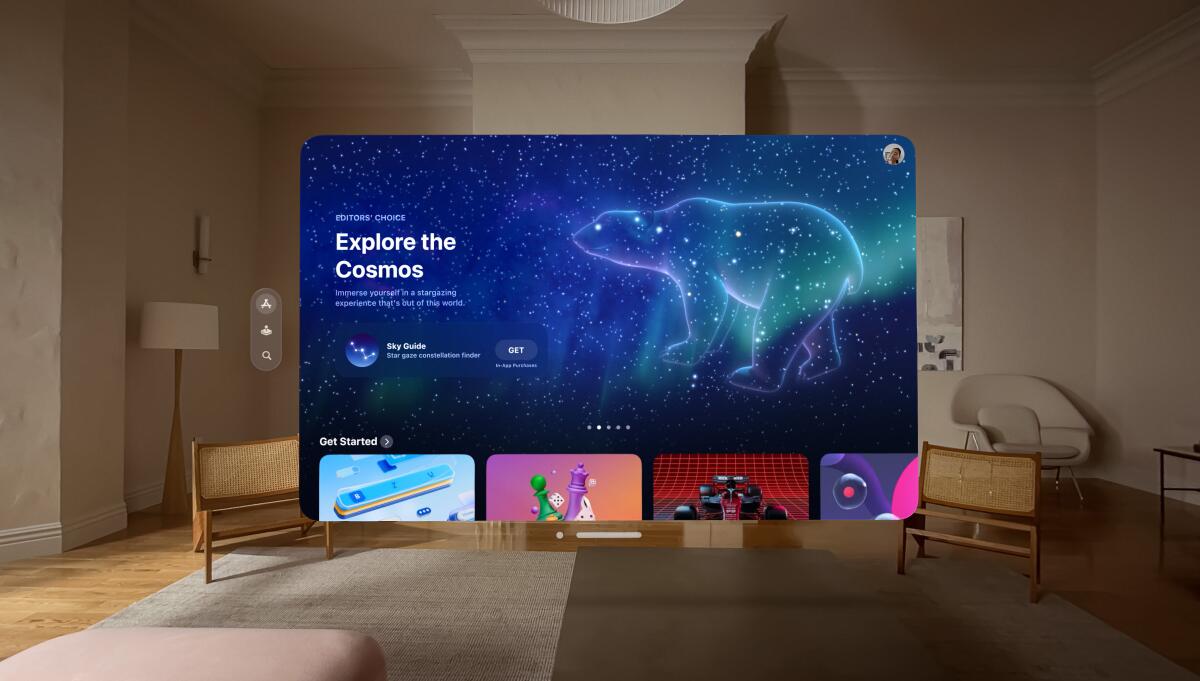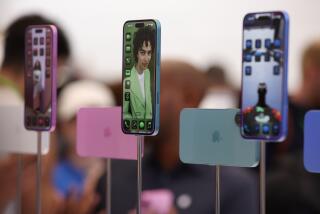Skeptical about VR goggles? How Apple and Disney could create the future of entertainment

- Share via
When Apple announced its long-awaited augmented reality headset, Vision Pro, earlier this month, part of the pitch was that these “Ready Player One”-esque goggles would change how we consume entertainment.
With Walt Disney Co. Chief Executive Bob Iger on hand to show off visually immersive new features in entertainment and sports, it seemed like two of the best-known brands in the media world were placing their bets on augmented and virtual reality. Imagine seeing digital confetti rain down during a college football game, or watching “The Mandalorian” from the desert sands of Tatooine.
Having content from Hollywood studios such as Disney has long been seen as a way to take the virtual reality business mainstream after years of false starts in the once-frothy sector. Part of the reason pricey VR headsets have failed to fulfill their promise as the future of entertainment is the lack of compelling stuff for customers to play with.
“Without content, it’s a mansion with no furniture,” said Dan Ives, a managing director and tech analyst at Wedbush Securities.
But at $3,499 a pop, the Apple headsets may not be revelatory enough to convince lay consumers the price tag is worth it. To a skeptic, the functions Iger presented might even come off like gimmicks.
“When I watch ‘Ted Lasso,’ I want to watch it with my wife, sharing the same screen,” said Wagner James Au, the author of the forthcoming book “Making a Metaverse That Matters.”
Vision Pro does have utility, Au said, but it seems geared more toward productivity than entertainment. The ideal user might be a Disney employee, not a Disney fan.
The uses Apple and Disney have presented so far are a bit of a Trojan horse, experts said. Apple’s target audience for the high-tech ski goggles isn’t consumers; it‘s other companies. The tech giant needs media brands, entertainment studios and software developers to start getting on board with this tech so that when customers show up en masse, there’s a suite of AR-exclusive content waiting for them.
“I don’t think it’s a general consumer product right now,” said Brandon Ross, partner and tech analyst at the research firm LightShed Partners. Just like it was the iPhone’s vast third-party app store that rocketed those devices into the mainstream, he continued, Vision Pro “is being put out there to start to develop an app ecosystem around it.”
Having 2D streaming video apps, such as Disney+, integrated early on offers prospective users an easy-to-understand example of what the headset can do, Ross said. More interesting, though, will be the media that creatives make specifically for Vision Pro — content that could only ever exist in an AR format.
Disney in particular could eventually use the technology to bring new offerings to fans, allowing interactions with Mickey Mouse in kids’ living rooms or adding virtual flourishes to in-person experiences at theme parks. (Was that Iron Man flying over Cinderella Castle?)
The House of Mouse is uniquely suited for adopting this technology, said Matthew Ball, an investor and the author of “The Metaverse: And How It Will Revolutionize Everything,” pointing to the brand’s partnerships with the video game “Fortnite,” as well as its innovations in theme park and animation technology.

“Among all media companies, Disney’s IP has the most intuitive appeal” in augmented or virtual reality, Ball said via email. “For decades, children and adults have imagined themselves inside the world of Star Wars or Marvel. ... Disney’s parks are proof of this.”
By uncoupling a park such as Disneyland from constraints such as ride capacity, operating hours or the laws of physics, he continued, this technology could enable new, immersive ways of capitalizing on Disney’s intellectual property.
But so far it’s not clear what added value the average viewer would get from ditching their TV set to go all-in on Vision Pro, said Amy Webb, chief executive of the Future Today Institute, a consulting firm.
Unless Disney secretly has a whole new category of AR-specific media up its sleeve, she asked, “What is this going to provide that is significantly better than the current TV viewing experience?”
In that sense, Apple may have announced this product as a means of priming the pump for a future the company is trying to build. In other words, a metaverse — that trendy Silicon Valley catchall used to describe 3D virtual worlds.
“I just wonder if Apple is envisioning a world where the two-dimensional screen kind of goes away, and the first version of this product is meant to help cross that bridge,” Webb said.

Apple did not respond to a request for comment. Disney didn’t make executives available to comment.
The entertainment world is littered with attempts to make augmented or virtual reality headsets a thing.
Magic Leap, at one point the sector’s wunderkind, pivoted to a less flashy enterprise approach after its consumer-focused AR headsets underperformed. Meta — the most prominent player in the space prior to Apple’s entry — recently cut the prices on its Quest headset line amid faltering Quest 2 sales, and has struggled to build a user base for its “Horizon Worlds” virtual environment.
Data suggests that interest in AR and VR headsets slumped in 2022. American teens expressed low interest in the tech earlier this year.
“When we were most excited about VR and AR, we had at least four different manufacturers of headsets, none of which had significant penetration into the market,” said Jay Tucker, executive director of UCLA Anderson’s Center for Management of Enterprise in Media, Entertainment and Sports. “Imagine trying to create a virtual reality experience. How much would you invest in that, knowing that your audience is the subset of people who bought [one] particular headset?”
(That hasn’t stopped media companies from dipping their toes. NBCUniversal’s streaming service platform, Peacock, recently became available on Quest headsets.)
Apple wants to seize the chance for a single company to be the standard device-maker for the AR sector, Tucker added, giving developers confidence that there are enough users in the ecosystem to make investing in original AR content worthwhile.
Deals with companies like Disney could break the ice.
The Apple-Disney partnership isn’t the first time the two firms have worked together, either.
Former Apple CEO Steve Jobs was at one point Disney’s largest single shareholder after selling Pixar. Disney Channel and ABC, which Disney also owns, were the first TV networks to put their shows on iTunes, and Disney Studios was the first film studio to debut movies there.
Iger has even said the two companies may have merged were it not for Jobs’ untimely death. Perhaps they still may — this time, in the metaverse.
More to Read
Inside the business of entertainment
The Wide Shot brings you news, analysis and insights on everything from streaming wars to production — and what it all means for the future.
You may occasionally receive promotional content from the Los Angeles Times.











